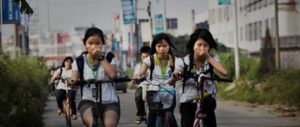Nanjing’s historic plane trees, which line the streets of China’s “southern capital”, are being uprooted to make way for an expansion of the subway system. In response, a movement has sprung up to protect this aspect of the city’s cultural and natural heritage, gaining strength online and even spreading across the Taiwan Strait, where it has fast become a hot political issue.
The Beijing News reported that, on March 9, over 40 plane trees (sometimes called French phoenix trees) on Nanjing’s Taiping North Road were dug up to make way for a subway station. Angry locals and netizens took to the streets, tying green ribbons to trees along the pavements under the slogan “Save the Nanjing plane trees, build a green Great Wall”. Others used microblogs to pass on photos and information and encourage more people to join the campaign.
Government figures show that construction plans for subway lines 3 and 10 involve moving 1,100 trees from Nanjing’s roads. Of these, 200 are Chinese plane trees, some of them 60 years old. Originally, the number of affected trees was yet higher: 2,600 were to be moved, before discussions with subway authorities prompted a re-think.
“The plane trees are an emblem of Nanjing. Old people come back from overseas just to see them,” one local told a Jiangsu news programme. “Why do they have to cut down so many for the subway? It’s a real shame.”
The plane trees lining Nanjing’s streets have come to be a symbol of the city. In 1928, the body of Chinese revolutionary and co-founder of the Kuomintang party Sun Yat-sen was moved here from Beijing. Liu Jiwen, Nanjing’s first mayor, chose to line the procession’s route to the mausoleum with plane trees. Those roads are now collectively referred to as “Sun Yat-sen’s streets”.
News of the threat to the trees quickly spread from mainstream media to the internet, where it became a popular topic in discussion forums. A well-known song by popstar Wang Feng was rewritten as a tribute to the trees, with one line reading “If one day I’m cruelly chopped down, please bury me in the spring.”
Nanjing-based environmental NGO Green Stone asked supporters to upload photos of themselves holding campaign signs to a microblog group. That group was created by media personality Huang Jianxiang and by March 18 had almost 10,000 members and nearly 17,000 messages.
Head of Green Stone Li Chunhua said that, while trees in Nanjing have been cut down before on account of subway construction work, this time the public reaction has been stronger – and, she added, microblogs have played an important role in disseminating information.
Huang Jianxiang, television host Meng Fei and movie director Lu Chuan all publicised the issue on their microblogs. Huang has more than 4.2 million subscribers on Sina, China’s largest internet portal, and Meng another 1.8 million. Meanwhile, on Tencent’s microblogging platform, 6.7 million people follow Meng and over 7.9 million follow Lu Chuan.
Netizens joined in, spreading word of the movement via online polls and forwarding microblog messages. By March 18, the message about the “Green Great Wall” event had been forwarded more than 15,000 times. In one poll, over 3,800 voters – 98% of the total – said there should be a temporary halt to the tree-removal programme to allow time for reassessment.
However, at some point, the flow of information was apparently cut off. On March 18, a search for “Nanjing” in Huang Jianxiang’s Sina microblog only brought up messages sent before June 2010 – no communications about the trees could be found. Similarly, a search for related terms on other Sina microblogs failed to turn up any results, while Meng Fei’s messages about the trees on Tencent, another internet portal, also disappeared.
Even so, interest in the issue continued to spread and attract more media attention. Within days, it had become one of the biggest news stories, both locally and nationally.
Then, on the 100th anniversary of China’s Xinhai Revolution, Kuomintang (KMT) party, historically associated with Nanjing, started to pay attention. Qiu Yi, a well-known political commentator and member of the KMT’s central standing committee, wrote on his microblog: “As both sides of the Straits celebrate the centenary of the Xinhai Revolution, the Nanjing government is felling or moving historic plane trees to build a subway. As a member of the KMT central standing committee I must express the deepest opposition. How can the KMT leaders remain silent?”
He added that he had talked to KMT vice-chair Chan Chuen-pao about the story and the symbolic importance of the plane trees, and that Chan had fully agreed and promised to pass the information on to Taiwanese leader and KMT chairman Ma Ying-jeou.
According to United Daily, on March 17 Qiu Yi proposed to the KMT standing committee that the Association for Relations Across the Taiwan Straits and the Straits Exchange Foundation (the bodies set up by both sides to handle technical or business matters between the two sides) be used to deal with the issue. Some days later, netizens in mainland China arranged a march in defence of the trees, saying that if they could survive the Nanjing Massacre – the period following Japan’s 1937 capture of the city, during which hundreds of thousands of its inhabitants were killed – they could survive a subway scheme.
Qiu said he had spoken on the phone to Nanjing mayor Li Jianye, who had given assurances he would handle the situation appropriately. But a subsequent press release from the Nanjing government indicated little had been done to quell concerns.
The local authorities explained that the trees were not being felled, but rather moved for replanting. But public anger remained strong. Chief reporter at Nanjing Times Zhu Fulin followed up on a story from 2006, when 190 sycamores were moved during construction of Nanjing’s subway line 2. He discovered that, of 83 trees moved to a nursery in Baixia district, 68 had died. The largest, a sycamore with a 2.8 metre circumference, was 80 years old. When moving the trees in April 2006, the parks and greenery authorities promised that 80% would survive. Instead, 80% had perished.
According to Southern Weekend, head of the local landscaping bureau Xie Zilai promised in 2006 that not one of 190 large trees being moved would die: “Contracts will be signed and, if any die, questions will be asked.” The trees can’t be moved back now, and nobody is interested in following up on Xie’s promise. In any case, he has moved jobs.
Writing on his microblog, Zhu Fulin said: “We don’t just want the government to move fewer trees – more than that, we want it set up urban-management mechanisms that permit public participation. We’re not obsessed with the 80% death rate; we just want to know where the taxpayers’ money went.”
The March 17 issue of Southern Weekend looked back at the construction of the subway line 2 five years ago, finding that greater transparency had resulted in less controversy. Before the trees were moved for that project, the subway and landscaping authorities published details of the plans in the media and held a press conference on measures being taken to protect the trees. To make sure the process went smoothly, even the numbers of trees to be moved for each station was published, as well as the times at which they were to be moved. But the construction of subway line 3 has not involved the same degree of consultation or publication of information.
Facing pressure, on March 15 the city government finally responded, saying it would improve plans to protect the trees. And, on March 18, the government said it was halting tree-moving activities while it reviews and optimises the plan. Li Chunhua said that Green Stone is actively working to form a group consisting of NGOs, the media, experts and the public, to work as a third-party participant reflecting public wishes in government planning.
According to a March 22 report in 21st Century Herald, a document drawn up by several different departments in the Nanjing government and submitted to the Nanjing People’s Congress for consideration, recommends that Nanjing be the first city to implement new “green cities” legislation.
Tensions between rapid urbanisation and environmental and cultural protection are common throughout China. Academic Xiong Peiyun said: “The days of ‘violent revolution’ may be fading, but ‘violent construction’ is everywhere. If it wasn’t for these huge protests, every tree in Nanjing might have ended up being felled. The logic of ‘violent construction’ is simple – if nobody protests when 3,000 trees are felled, next it will be 30,000, and then 300,000 after that.”
Homepage image from boo shows an uprooted plane tree in Nanjing.


